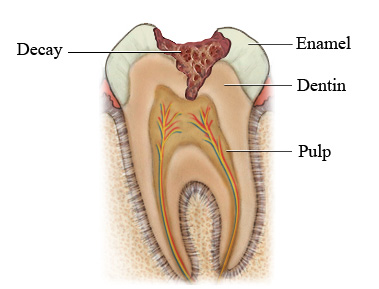Dental Caries Or Tooth Decay

Tooth decay is damage that occurs when germs (bacteria) in your mouth make acids that eat away the tooth structure. It can lead to a hole in the tooth, called a cavity. If not treated, tooth decay can cause pain, infection, and tooth loss.
Tooth has three layers.
The more layers that are affected by decay, the worse the damage.
Bacteria and food can cause tooth decay. A clear, sticky substance called plaque is always forming on your teeth and gums. Plaque contains bacteria that feed on the sugars in the food you eat.
As the bacteria feed, they make acids. The acids attack the teeth for 20 minutes or more after you eat. Over time, these acids destroy tooth enamel, causing tooth decay.
Things that make you more likely to have tooth decay include:
Tooth decay usually doesn't cause symptoms until you have a cavity or an infected tooth. When this happens, you may have:
If you have a toothache, see a dentist. Sometimes the pain will go away for a while, but the tooth decay will keep growing. If you don't get treatment, your cavities could get worse and your tooth could die.
Tooth decay can be seen as blackish discoloration of the tooth, which may present with occasional pain on drinking water or taking sweets in the initial stages of tooth decay. However, once the decay enters the pulp the pain is continuous and may be associated with a swelling. Hence it is always better to get your dental decay treated as soon as you notice it.